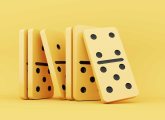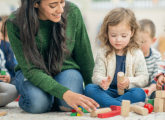Over the course of eight articles Maria Kay highlights the close relationship between music and literacy in the early years, and suggests simple activities to help you develop children’s skills…
Identifying and reciting oral rhymes offers a way for children to demonstrate their phonological awareness – that they understand that words consist of smaller units such as syllables and rhyming endings. Rhymes may be spoken, chanted or sung; reciting examples familiar to children encourages them to anticipate the words to come. For example, “Look in the box, take a peek, the mouse wants to play hide and… ?” You will have no problem supplying the word, ‘seek’. Children need to learn that sounds can match, and that they may subsequently have the same spelling pattern. Rhymes also help children to appreciate the structure of language, and can be used to convey information or tell stories. Goswami and Bryant, in Phonological Skills and Learning to Read (Erlbaum, 1990), state that, “Children who are sensitive to rhyme eventually do much better at reading.” They believe that the ability to identify rhymes is a skill that children bring to reading – i.e. being able to identify rhymes will have a positive effect on literacy skills. See also Goswami’s article ‘A reason for rhyme’.
Below is a selection of rhymes and a well-known song with alternative verses, all based on a mouse theme. Some require the use of a finger mouse puppet – you can find out how to make your own in five minutes here.
This first rhyme does not require the finger mouse, as you can vary the rhyme to include different animals.
Here is a Box
Here is a box (Make a fist)
Put on the lid (Make a lid with your other flat hand)
I wonder whatever inside is hid? (Peep inside) Why, it’s a (mouse) without any doubt (Wiggle finger up through fist)
Open the box and let him jump out! (Jump the ‘mouse’ out of the box and make a squeaking sound)
Repeat with different creatures. Ask a group of children what is in their box. Take turns to recite the rhyme, each time with a different creature. Alternatively, when you say, “Why it’s a…”, make an animal sound and ask the children to guess what might be hidden. This will help children to listen carefully and match the sound to the animal.
Round and Round the Haystack
Round and round the haystack
Ran the little mouse
One step, two step
Into his little house!
You can use the finger mouse for this rhyme! Do actions as for ‘Round and Round the Garden’. Circle a child’s palm with the mouse, count the two steps, then run the mouse up the child’s arm to tickle them. You can omit to say the word ‘house’ to see if the child can supply the word.
Mouse Mouse
Mouse, mouse, in your house, would you like cheese for lunch?
Yes, I would, yes please, kind sir, mmmm,
munch, munch, munch!
Ask the children to sit in a circle and walk their mice into the centre towards some imaginary cheese. When they reach the cheese they can make munching sounds!
Hickory Dickory Dock
Hickory dickory dock
The mouse ran up the clock
The clock struck one (Clap!)
The mouse ran down
Hickory dickory dock
Hickory dickory dock
The mouse ran up the clock
The clock struck two (Clap! Clap!)
The mouse sneezed – atchoo!
Hickory dickory dock
Hickory dickory dock
The mouse ran up the clock
The clock struck three (Clap! Clap! Clap!)
The mouse went “Wheeeee….”
Hickory dickory dock
Help children to make up more rhymes for the next numbers. Use a clock face as a prop, indicating the various times. Use this to help children to learn to read numbers and to appreciate that the passing of time can be represented on a clock. There is a video of this rhyme on YouTube as part of the rhymes for the Chatterbox Challenge with Sounds and Symbols.
My next article will explain the difference between beat and rhythm, the relationship between rhythm and syllables, and examine why being able to maintain a rhythm is important to reading and writing.
Maria is the author of Sound Before Symbol: Developing Literacy through Music and Alphabet Book + More: A Sounds and Symbols ‘literacy through music’ book. Her Sounds and Symbols Literacy through Music Resource Pack (£489) is available now. It is a comprehensive, research-based and informative resource, full of engaging activities and is perfect for building foundational literacy skills in the early years (0–8 years). Email .(JavaScript must be enabled to view this email address) or visit bryantandkaypublishing.co.uk

Mathematical development – fun with doubles
Editors picks

Pretend play – How to harness its learning potential
Editors picks

All About Me – Making maths personal in Early Years
Editors picks
